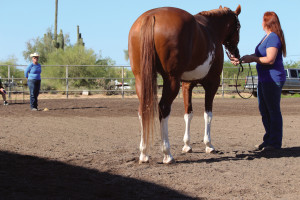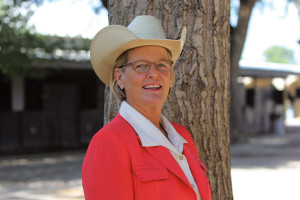Cinching the Clinic
Click here to read the complete article
Tips from the Experts about How to Get the Most Out of Attending a Clinic
by Delores Kuhlwein
 Clinics are popping up all over the place these days. They range from demonstrations to pre-World Show boot camps and everything in between. Large horse shows like the All-American Quarter Horse Congress, APHA, ApHC, and AQHA World Shows, and the Arizona Sun Circuit are just a few events that now include free clinics in their schedules as a perk for exhibitors and the public.
Clinics are popping up all over the place these days. They range from demonstrations to pre-World Show boot camps and everything in between. Large horse shows like the All-American Quarter Horse Congress, APHA, ApHC, and AQHA World Shows, and the Arizona Sun Circuit are just a few events that now include free clinics in their schedules as a perk for exhibitors and the public.
While some are geared to the rider who doesn’t have a horse in full-time training, all competitors are discovering the allure of accessing advice from experts in just about every field.
To ensure the best experience possible, having a game plan is always a good idea. Those in the know, including top clinicians and professionals, offer sound advice about the best way to get the most out of attending a clinic.
Considering a Clinic
Amateurs, youth, and professionals alike can find clinics useful, according to judge and clinician Doug Huls, who is no stranger to clinics as Show Director for the Arizona Sun Circuit. The event hosts a multitude of free clinics for the cow horse competitor, those interested in natural horsemanship, and the serious all-around rider.
“Everyone usually learns at least a few things from the clinician. At the very least, the experience opens your mind and creates constructive thought on your riding and training,” Huls says. “Clinics also offer a great opportunity to bring new individuals into this industry that we’re so passionate about.”
Judge Michael Ochetto, who teaches clinics ranging from Showmanship and Horsemanship to Ranch Riding agrees. He says, “It’s another avenue for the associations and exhibitors to get together and really work on getting better at what they love to do. The upswing in the number of clinics held today is a good statement that our industry is growing, too.”
As a much sought-after instructor, judge Holly Hover recognizes clinics as great motivators. “Clinics are a great tool, especially for those who keep their horses at home and ride themselves,” she says. “Even though it’s hard for a clinician to cover everything in 2-3 hours, you can still come away with 3-4 good tips for your program.”
How to Choose
Choosing the right clinic type and category should be more than just a passing thought. Ochetto advises seeking out a clinic that includes a format and has detailed information that’s released ahead of time. “The attendees should know what they’re getting into and how to be prepared, such as knowing what equipment to bring.”
Hover adds that factors like size and proper grouping of skill level are important considerations when selecting a clinic, because they can make or break the learning experience. “Five people would probably learn a lot in four hours, but that learning will diminish with a larger group or a longer time frame.” She advises that participants make sure they’re registered for the right group as well. “It makes the experience better for everyone if you’re in an advanced Showmanship clinic and you can already set your horse up, for example.”
Hover also says not to dismiss clinics with demonstrators, because she has found they’re some of the most successful types. “A good demonstration can have a novice rider, an intermediate rider, and an advanced rider modeling concepts that will cover a lot of bases for everyone,” she clarifies.
Preparing for a Clinic
Going into the clinic ready to receive instruction is important, particularly if the horse is part of the experience. “If you’re attending with a horse, have the horse mentally prepared to accept the training,” Huls advises. “A horse that has not been longed or exercised regularly will slow the ability for the animal and rider to gain the maximum benefit.”
Setting some goals ahead of time is a crucial step beforehand, too, says Ochetto. “You need to know what your overall goals are, and within that, what goals you wish to accomplish that particular day with that clinician.” He explains that part of the goal setting could include wearing show tack and clothing for the session. “Clinics are a little informal sometimes, so you need to be prepared like you’re at a horse show, because that’s where you’re nervous. Your good clothes and tack feel different to the horse and you! I think it’s valuable to come as if you’re going to a horse show.”
All three experts advise to approach each clinic with an open mind. Hover emphasizes, “What you need to accept might be a different point of view, because very often it’s a judge’s perspective for you to put into your portfolio.” Ochetto says that if he comes across a conflicting philosophy, as a trainer, he advises his clients to keep their minds open. “I just say to my clients that this might be a bit different [than what you’re used to]. You can decide on your own afterward what’s best,” he says.
Huls agrees that the right mindset is key, because he often finds that clinicians have different philosophies. He says, “It doesn’t mean one is right and one is wrong. There are often many ways to solve the same problem. Trying to take home a few things from a clinic to become a better horseman or horsewoman is the goal. If you want the whole program, you should send your horse to the trainer or do everything you can to learn about his/her program. A clinic is about gaining knowledge and perspective.”
Where a participant’s trainer fits in, like everyone else, is right in the middle of the clinic.
“It’s important to note that everyone needs to have an open book,” Hover says. She continues, “The clinic should be a joint effort between the trainer and the attendee. This is primarily because it’s very difficult for people to take pieces from different programs and bring that information back in a secondhand explanation. As a trainer, I’m open to going to clinics so the information is being analyzed correctly. Hopefully, there is open communication between you and your trainer, because the last thing clinicians want to do is undermine a current program. They’re just there to give their professional opinion, and they expect the participant has made the choice to attend with primary trainer approval or accompaniment.”
“In this industry, learning never stops,” Ochetto adds. “Clinics are a great place to learn, and your trainer has to be comfortable enough with that idea to give the okay. It does offer another perspective, but that doesn’t mean a trainer will lose a client. Maybe that one clinician is helping you with a question your trainer hasn’t been able to answer.” He also encourages trainers to participate in clinics to expand their own horizons. “My biggest teachers are my colleagues; listening and talking to them helps me learn what to do and what not to do,” he says.
After the Event
When the clinic is over, Huls explains that riders can consider it a success if they gained even one or two new strategies to incorporate into their regular program. “When I work with a student, our focus is always on only one or two items. In my mind, you always try to simplify. Having your focus on too many things was never successful in my lessons with students,” he explains.
He reminds participants to follow up to make the most of the experience, particularly by practicing what was learned. “Be certain to practice in your daily riding what you thought might be useful. If the clinician gave you drills and approaches you may not have tried in an area you were struggling with, you must practice enough to realize if what you learned was valuable. If it wasn’t what you needed, at the very least it opened your mind to where you may come up with the solution from your own creative thinking. If you don’t practice nor think while you’re riding, you will not improve,” he concludes.
Taking it From Here
From the apparent success and widespread increase in seminars, demonstrations, and clinic offerings, it’s apparent they aren’t going away any time soon. Finding one that suits your needs is getting easier, and attending them is becoming part of the norm due to the educational nature of the business.
“No matter your success,” Ochetto concludes, “you will always continue to learn something, whether you’re a client, a trainer, or a horse. The industry is like a constant continuing education program, because you’re always gaining knowledge. Take advantage of the clinics offered, because they can be a great learning tool.”











